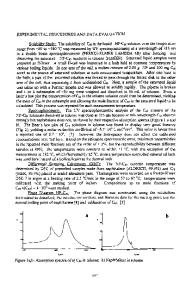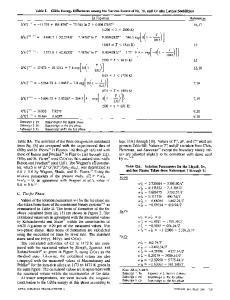Optimization of binary thermodynamic and phase diagram data
- PDF / 727,337 Bytes
- 7 Pages / 603.28 x 783.28 pts Page_size
- 72 Downloads / 356 Views
I.
INTRODUCTION
FOR a
binary solution phase, many diverse sets of experimental thermodynamic data may be available. Activities of one or more components at various compositions and temperatures may have been measured by emf, vapor pressure, mass spectrometric, or other techniques. Enthalpies of mixing may have been determined calorimetrically. The experimental equilibrium phase diagram is also a source of thermodynamic data. If the Gibbs energy of fusion of a stoichiometric component is known, for example, then the activity of this component in the liquid phase can be calculated (nonisothermally) along its liquidus. Even a miscibility gap is a source of thermodynamic data, since the activity of either component is the same at both ends of any tie-line, even though the actual values of the activities may not be known. The various thermodynamic properties are all related via the Gibbs-Helmholtz and Gibbs-Duhem equations. If sufficient data are available, then in principle it is possible to obtain one "optimum" equation for the Gibbs energy of the solution as a function of temperature and composition. Obtaining such an expression involves the critical assessment and correlation of all the data as well as the testing of the data for internal consistency. In practice, however, such an operation is not an easy task due to the complexity of the relationships among the various measured properties. The development and application of techniques to perform such analyses is a subject of current interest./-6 In the present article, a linear least squares optimization technique is proposed which can be used in a computer-assisted critical analysis of binary thermodynamic and phase diagram data including liquidus/solidus lines of components and intermediate compounds as well as miscibility gap boundaries. For a binary solution of components A and B, the integral molar Gibbs energy of mixing relative to the pure components is expressed as: A g = RT(XA In X a "~- X B In XB) + gE
[1]
ferent choice of the ideal terms in Eq. [1] may be more convenient.) ge may be expressed as a polynomial in the mole fraction XA: M
gE = E ~)mjnjXt~J(1 -- XA) nj j=l
[2]
where the ~b, .... are coefficients, M is , the total number of 2J . such coefficients, and mj and nj are positive integral powers. For example, in a regular solution, M = 1, ml = nl = 1, and ge is quadratic: 9
,
ge = ~b11XA(1 -- XA)
[3]
In a "sub-regular" solution, M = 2, and gE is cubic: gE = qbuXA(1 -- XA) ~- (~12XA(1 - - XA) 2
[4]
There is some freedom in how the two terms of a subregular solution expression may be chosen. For example, one could have written Eq. [4] in terms of c,bll and ~1, or in terms of ~b12and 4hl. All these cubic expressions would be equivalent. The coefficients ~br,:,: may be written as linear functions of temperature, T: (~mjnj = hmjnj - Tsmjnj
[5]
Hence, the integral molar enthalpy of mixing and excess entropy of mixing, assumed independent of T, are given in terms of the coefficients hm:j and Smj.j as: M
A h = ~ hmjnjX~(1 - XA) nj j=l M s e
Data Loading...











